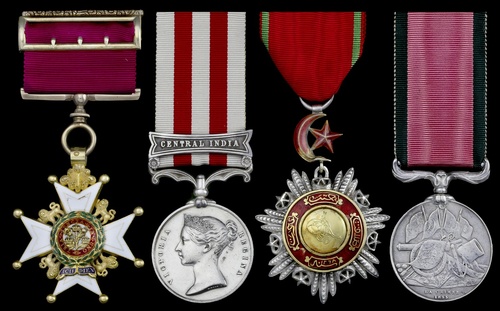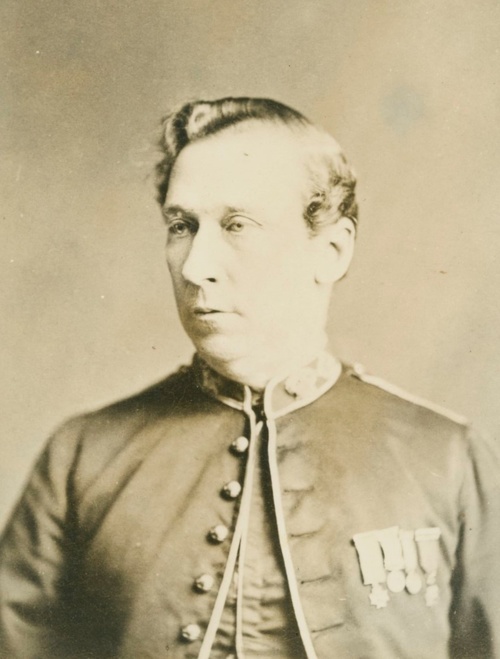Auction: 19002 - Orders, Decorations and Medals
Lot: 360
The outstanding Indian Mutiny C.B. group of four awarded to Lieutenant-General E. Wray, Royal Artillery, late Bombay Artillery; as Field Commissary at the Siege of Kotah in March 1858, Wray led the British bombardment, his 'hard work and energy' underpinning the successful British assault
Wray later became Inspector General of Ordnance and Magazines, Bombay Presidency, serving as an adviser to the Secretary of State for India. A fine memorial commemorates him at the Garrison Church, Woolwich
The Most Honourable Order of the Bath, C.B. (Military) Companion's breast Badge, gold (22 carat) and enamel, hallmarks for William Neal, London 1859, fitted with narrow swivel-ring suspension and gold ribbon buckle, small chips to white enamel on top arm and minor loss to wreaths; Indian Mutiny 1857-59, 1 clasp, Central India (Major E. Wray, Bombay Arty.); Order of the Medjidie, 4th Class breast Badge, silver, gold and enamel, the reverse inscribed 'May/June 1855 Kertch', minor chip to red enamel, the crescent suspension twisted; Turkish Crimea 1855, French issue, unnamed, fitted with replacement 'Crimea' suspension, light contact marks, otherwise very fine and better (4)
Provenance:
Baldwin's, 1967.
C.B. London Gazette 5 March 1861.
Order of the Medjidie London Gazette 2 March 1858.
Edward Wray, son of the barrister Charles Wray, was born at Georgetown in British Guiana on 27 November 1823. Nominated for the 1838-39 Season at Addiscombe by John Shepherd, a Director of the H.E.I.C., he passed the Public Examination on 11 December 1840 and was commissioned a 2nd Lieutenant in the Bombay Army. He sailed for Bombay aboard the Oriental on 2 March 1841. The following year he was posted to Scinde with the 2nd Company, 2nd Battalion, Bombay Artillery, under Captain W. T. Whitlie. Promoted to Lieutenant on 9 November 1842, he transferred to 4th Troop, Bombay Horse Artillery. On 16 January 1849, he was appointed Adjutant and Quartermaster of the Horse Brigade, Bombay Artillery, a post he held for nearly four years until 17 December 1852. He was promoted to Captain on 20 January 1853.
It is probable that shortly afterwards he returned to England on furlough, as in March 1854 he joined the Anglo-Turkish Contingent to take part in the Crimean War. This force, hurriedly assembled, was largely officered by H.E.I.C. officers on leave, many with brevet rank. Wray commanded a battery of Horse Artillery with the local rank of Major, joining the Kertch expedition in May 1855. Situated at the Crimea's eastern extremity, Kertch had provided Sebastopol with a supply line, enabling the city to withstand the Allied siege. When the Allies reached it on 22 May, the port was flattened and Russian naval power ceased to exist overnight (see London Gazette, 28 June 1855). For his services Wray was awarded the 4th Class of the Turkish Order of the Medjidie (London Gazette, 2 March 1858). The reverse of his Badge bears the inscription: 'May/June 1855 Kertch'. He also received the Turkish Crimea Medal.
Wray returned to India in 1856, the October 1857 Muster Roll showing him as Commissary of Ordnance at Ahmedabad. He was present with the troops under Colonel J. Holmes at the siege and capture of Awah on 19-23 January 1858. When the Rajputana Field Force was formed under Major-General H. G. Roberts, Wray was appointed Field Commissary of Ordnance, with responsibility over the six 18-pounders, four 12-pounders, four 8-inch mortars and four 8-inch howitzers which comprised Roberts' siege train. This force reached Kotah on 20 March. Kotah had fallen to the rebels six months earlier, but a small pocket of loyalist troops still held its ancient Garh (citadel), on the eastern bank of the River Chambal.
Roberts occupied high ground on the Chambal's western bank. From there the British guns gave covering fire to a 300-strong storming party of the 83rd Foot, which crossed the river in boats. Reinforcing the beleaguered loyalist garrison, the 83rd gradually drove the rebels back, house by house. On the evening of 27 March, under cover of darkness, several British guns were spirited over the Chambal, under the mutineers' noses. As dawn broke they opened up with canister, decimating the rebel formations. That afternoon Wray conducted a fearsome artillery bombardment, using enfilading fire from guns on Kunadi Ridge. Three days later the rebels surrendered, with the loss of seventy-five guns.
In his subsequent despatch, General Roberts described the work of the Artillery at Kotah as 'having been almost beyond belief'. Of Wray himself, Roberts reported: 'To Major Wray, Field Commissary of Ordnance, my most especial thanks are due for the uninterrupted hard work and energy he has displayed throughout' (London Gazette, 11 June 1858, refers). Wray was awarded a Brevet Majority on 6 June 1858. After Kotah the Rajputana Field Force pursued Tantia Tope, defeating his forces at the Banas River on 13 August. One of the key leaders behind the Cawnpore massacre of 27 June 1857, Tope was hanged by the British at Shivpuri on 18 April 1859.
On 6 July 1860, Wray was appointed Agent for Gunpowder and Superintendent of the Factory at Bombay. He held this appointment until 20 October 1862, and was made a Companion of the Bath for his services. He advanced to Lieutenant-Colonel on 18 February 1861. On 10 March 1863, he was appointed Inspector General of Ordnance and Magazines, which involved the superintendence and control of the Ordnance Department of the Bombay Presidency. He held this post until 26 July 1864, subsequently returning to England and joining the Ordnance Select Committee in October 1865. He was made Brevet Colonel on 18 February 1866, and was promoted substantively on 26 April 1866. He joined the Staff of the Director of Artillery in December 1868 and acted as adviser to the Secretary of State for India, an appointment he held for just over ten years. He was promoted to Major-General on 1 October 1877, and on 31 December 1878 he retired with the rank of Honorary Lieutenant-General. Wray died in London on 27 January 1892. A memorial was erected in his memory by his brother officers in the Garrison Church at Woolwich.
Sold with two copied portrait photographs from the collection of the Royal Artillery Institute, Woolwich.
Subject to 20% VAT on Buyer’s Premium. For more information please view Terms and Conditions for Buyers.
Sold for
£3,800
Starting price
£2400







